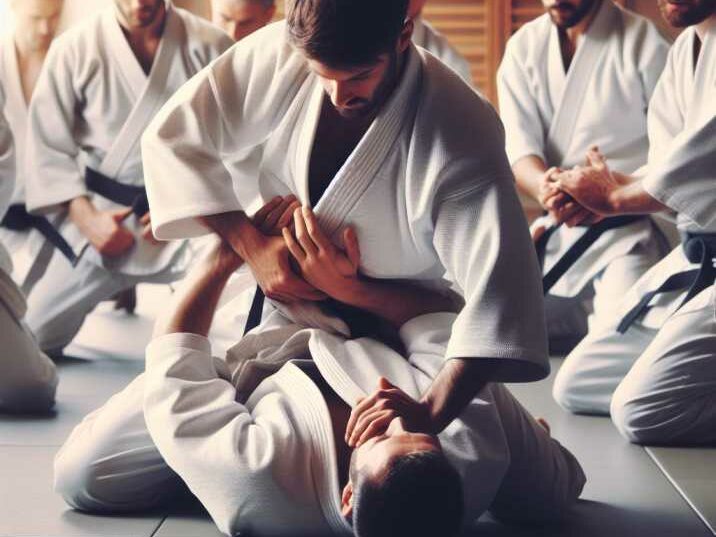Inrtoduction
Table of Contents
Ever envisioned yourself effortlessly deflecting attacks and controlling opponents twice your size, akin to Steven Seagal in action-packed movies? Such imagery often accompanies discussions about Aikido, an ancient Japanese martial art renowned for its graceful yet effective techniques. Is Aikido effective in a real fight? that’s truly held up in the chaos of a real-life brawl?
In this comprehensive article, we delve into the essence of Aikido, dissecting its strengths, limitations, and practical applications in self-defense scenarios. By combining the insights from two distinct perspectives, we aim to provide a holistic view tailored to the needs and interests of readers in the United States.

What is Aikido?
Aikido, translated as “the way of harmony,” embodies a philosophy rooted in redirecting an attacker’s aggression rather than meeting it with brute force. Unlike some martial arts that prioritize strikes or grappling, Aikido emphasizes fluidity and adaptation, leveraging an opponent’s momentum to gain control and neutralize threats.
Key Principles of Aikido
1. Ki (Energy): Aikido practitioners harness their internal energy (ki) to execute techniques with precision and effectiveness.
2. Atemi (Strikes): While not the focal point, Aikido incorporates strikes to vulnerable points to disrupt an attacker’s balance and create openings for control.
3. Tai Sabaki (Body Movement): Mastery of footwork and body positioning is crucial for manipulating an attacker’s movements and maintaining control of the encounter.
4. Ikkyo (One Point Control): Fundamental to Aikido, this technique involves seizing control of an attacker’s joint, typically the wrist, to execute throws and immobilizations.
Is Aikido Effective in a Real Fight?
Strengths:
- De-escalation: Aikido techniques prioritize control and restraint, facilitating conflict resolution without causing significant harm.
- Non-confrontational Approach: By emphasizing harmony and redirection, Aikido minimizes the risk of escalating confrontations.
- Effective Against Larger Opponents: Through leverage and proper technique, individuals of smaller stature can effectively neutralize larger attackers.
- Improves Overall Fitness: Aikido training enhances balance, coordination, and flexibility, contributing to holistic physical well-being.
Limitations:
- Realistic Training: Some Aikido dojos may lack realistic training scenarios involving resisting opponents, potentially limiting practical application in real-world encounters.
- Multiple Attackers: While adept at one-on-one confrontations, Aikido techniques may prove challenging to apply against multiple assailants simultaneously.
- Time and Dedication: Achieving proficiency in Aikido requires consistent practice and dedication, making it less suitable for immediate self-defense needs.
Who Can Benefit from Aikido?
Aikido offers a unique approach to self-defense that resonates with individuals seeking non-violent solutions and personal growth:
- People of All Ages and Fitness Levels: Modified training methods accommodate beginners and individuals with physical limitations, making Aikido accessible to a diverse range of practitioners.
- Those Preferring Non-confrontational Approaches: Aikido’s emphasis on redirection and harmony aligns well with individuals seeking self-defense strategies rooted in de-escalation rather than aggression.
- Individuals Interested in Personal Development: Beyond physical skills, Aikido cultivates qualities such as discipline, patience, and composure under pressure, fostering personal growth beyond the dojo.
Finding the Right Aikido Dojo.
Embarking on a journey to learn Aikido involves finding the right training environment suited to your needs:
- Research Different Styles: Explore the various Aikido sub-styles and their approaches to training, ensuring alignment with your goals and preferences.
- Observe a Class: Attend a trial class or observe a session to assess the instructor’s teaching style, the atmosphere of the dojo, and the level of emphasis on practical applications.
- Inquire About Instructors: Look for experienced instructors with a strong understanding of Aikido’s self-defense applications and a commitment to fostering a supportive learning environment.
Table of Information Is Aikido Effective in a Real Fight?:
| Topic | Description |
|---|---|
| What is Aikido? | A Japanese martial art emphasizing harmony and redirection of an attacker’s energy. |
| Key Principles | Ki (Energy) – Atemi (Strikes) Tai Sabaki (Body Movement) Ikkyo (One Point Control) |
| Strengths | De-escalation – Non-confrontational Approach Effective Against Larger Opponents Improves Overall Fitness |
| Limitations | Realistic Training Multiple Attackers Time and Dedication |
| Who Can Benefit | People of All Ages and Fitness Levels Those Preferring Non-confrontational Approaches Individuals Interested in Personal Development |
| Finding the Right Dojo | Research Different Styles Observe a Class Inquire About Instructors |
Conclusion
In conclusion, Is aikido effective in a real fight? While Aikido may not offer a one-size-fits-all solution to every self-defense scenario, its principles of harmony, control, and redirection provide valuable tools for navigating challenging situations with grace and composure. By approaching Aikido with a commitment to realistic training and personal growth, individuals can harness its transformative potential to enhance both their physical and mental resilience.
FAQs:
- Is Aikido effective for self-defense?
- Aikido can be effective for self-defense, particularly against untrained or less aggressive opponents. However, its practicality in real fights depends on various factors.
- Can Aikido techniques be used against multiple attackers?
- With proper training and adaptation, Aikido techniques can be applied in scenarios involving multiple attackers, although it requires a high level of skill and situational awareness.
- Does Aikido involve striking techniques?
- While Aikido primarily focuses on joint locks and throws, some schools incorporate striking techniques as supplementary training.
- How long does it take to become proficient in Aikido?
- The time it takes to become proficient in Aikido varies depending on individual aptitude, training frequency, and dedication. It typically requires several years of consistent practice.
- Is Aikido suitable for children?
- Aikido can be suitable for children, as it emphasizes cooperation, discipline, and non-violence. However, parents should ensure that the dojo provides age-appropriate instruction and supervision.


